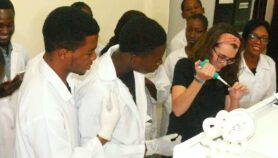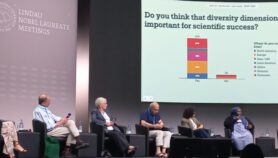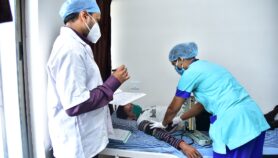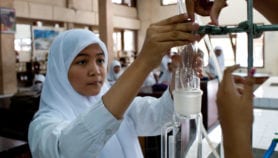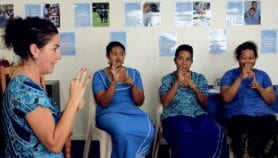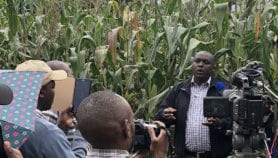By: David Dickson
Send to a friend
The details you provide on this page will not be used to send unsolicited email, and will not be sold to a 3rd party. See privacy policy.
World conferences of science do not have a good track record, particularly when one of their main functions is to generate new international funding commitments to support research in developing countries. The United Nations Conference on Science and Technology for Development, held in Vienna in 1979, failed in this objective; while the meeting ended with a promise to seek up to an extra US$250 million to support such efforts, spending in this area in fact dropped considerably over the following two decades, particularly in Africa. The conference's successor, held in Budapest 20 years later, sensibly managed to keep the issue of funding off the agenda.
There are, therefore, reasons to be cautious about plans for yet another such meeting, even if on a much more modest scale. This one is being planned to discuss ways of implementing proposals put forward last week by the world's leading professional scientific associations for promoting science and technology capacity around the world.
The proposals are contained in a report Inventing a Better Future: A Strategy for Building Worldwide Capacities in Science and Technology, prepared by a 12-member panel set up by the InterAcademy Council (IAC), a body whose members are 90 scientific academies from around the world. The panel's recommendations range from increasing the attractiveness of science courses for schoolchildren, to developing both centres and 'virtual networks' of excellence to boost skills and creativity in key areas of research.
The report acknowledges that two factors will be required to pursue these goals. The first is political will; it was a desire to get the message through to top decision-makers that led the IAC to present the report last week to UN secretary general Kofi Annan, in the presence of diplomats and government representatives from around the world.
The second is money. Here the report recommends not one, but two new funds to meet some of its objectives (See Academies call for two global science funds). And the meeting that it is planning to hold sometime later this year, probably at the Third World Academy of Sciences in Trieste, Italy, will bring together potential donors to make the case for a substantial increase in their investments in this field.
Reasons for optimism
Despite the initial scepticism, there are at least three reasons to be optimistic that such a meeting will be more successful than its predecessors. The first is that the panel's report, while lacking sufficient focus to really qualify as a 'strategy', nevertheless sets out a broad range of potential funding targets that have now been clearly identified by the scientific community. As such, it represents an attractive and imaginative à la carte menu from which potential donors can pick and choose to meet their own tastes and priorities. Indeed some items on the menu (such as the idea of persuading research students from developed countries to study for their PhDs in a developing country institution as part of the capacity-building efforts of the latter) have a novelty that may well have wide appeal.
The second reason for optimism is that the IAC's strategy deliberately seeks to bring together both public and private donors. Some of the naivety in the past about raising substantial new funds for research in developing countries has resulted from leaving this task to governments and aid agencies. While some have responded generously, others have been reluctant to back it as a political priority, making consensus difficult to achieve.
By placing emphasis on the key role that private foundations could play, the IAC's report has both broadened the potential funding base, and opened up the path for a strategy that does not depend on waiting to catch the eye of political leaders in the industrialised world. At the same time, it usefully highlights some of the issues that currently impede successful public/private collaboration, such as the problems caused by excessively rigorous laws on intellectual property or access to scientific databases.
Finally, there are signs that the timing may be propitious for bold new initiatives. Certainly within developing countries themselves, there are many promising indications that support for science and technology is coming to be recognised as an important political priority. Look, for example, at the way that the larger developing countries, including Brazil, Mexico, India, China and South Africa, have each agreed to provide fellowships to help their poorer counterparts train their leading researchers of tomorrow. Or even at how India and Pakistan have recently chosen to use the cementing of ties between their two scientific communities to symbolise a commitment to work jointly towards the economic prosperity of South Asia (see India and Pakistan cement scientific ties).
Statement of faith
But the scepticism is not totally unfounded. Much of the content of the IAC's report is put forward as a statement of faith, rather than a carefully crafted argument designed to persuade doubters. Those who believe that science and technology are drivers of social and economic success frequently fail to give sufficient weight to other factors (in particular, the need to stimulate demand for their products). At best, such beliefs come over as somewhat idealistic; at worst, they can be seen as self-serving.
Neither characteristic is particularly helpful in approaching funding organisations, whether public or private. The report's weakness is perhaps revealed most significantly by the fact that there is little discussion of a social agenda that science might serve; the word 'poverty' is scarcely mentioned, neither is there any significant reference to the Millennium Development Goals, the compass that most governments currently use to set their development assistance strategies. Rather, the basic approach of the IAC report is a 'supply driven' model of science and technology, one whose flaws have been frequently exposed elsewhere, but still retains a grip on important parts of the scientific community.
Related to this is the relative lack of attention to ways in which a more 'demand driven' approach can be integrated into science and technology policies, particularly those of developing countries. The issue is not ignored; certainly the support voiced for the 'sectoral funds' approach being explored in countries such as Brazil and Argentina, reflects an awareness of the issue. But the dominant perspective still appears to be a conviction that science policy should be set by scientists.
The need for sensitive implementation
Such shortcomings, however, should not detract from the potentially important role that the IAC report could play, provided its recommendations are implemented in an effective and sensitive fashion. It contains much discussion of the role of both centres and 'virtual networks' of excellence. These work well when they can create a critical mass of talent. Their danger is falling prey either to elitism — isolating the best researchers from university teaching responsibilities, for example, is a mixed blessing — or the type of squabbling that inevitably results when such centres become seen as political rewards, and decisions on where they are to be located are taken accordingly.
Another danger is the need to avoid any tendency to reinvent the wheel. Much of what the IAC recommends is already being carried out through organisations such as the Third World Academy of Sciences (for example, its efforts to build up networks of excellence in Africa). It is important that any new impetus provided by the report goes into strengthening these initiatives, rather than being tempted to start afresh.
Providing these hazards can be avoided, however, there is no reason that the publication of the IAC report should not act as a timely call to arms. The worst thing that could happen now would be for the report to gather dust on the shelves of academies around the world (the fate, sadly, of many previous sets of recommendations in this field). What is needed is a practical implementation strategy, in which both donors and potential beneficiaries have an active stake. If the forthcoming meeting can achieve this, it will avoid the fate of its predecessors, many of whose recommendations have faded gradually into oblivion.
Link to report: Inventing a Better Future: A Strategy for Building Worldwide Capacities in Science and Technology
More on Capacity building
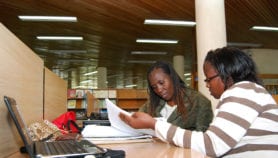
Script media release
Journalists offered ‘big break’ mentoring opportunity from Radio Nigeria
03/04/19






